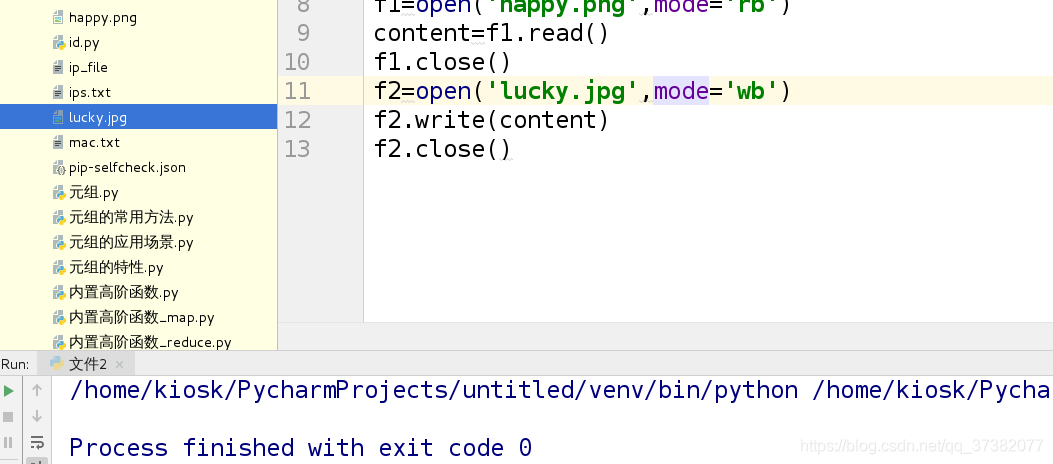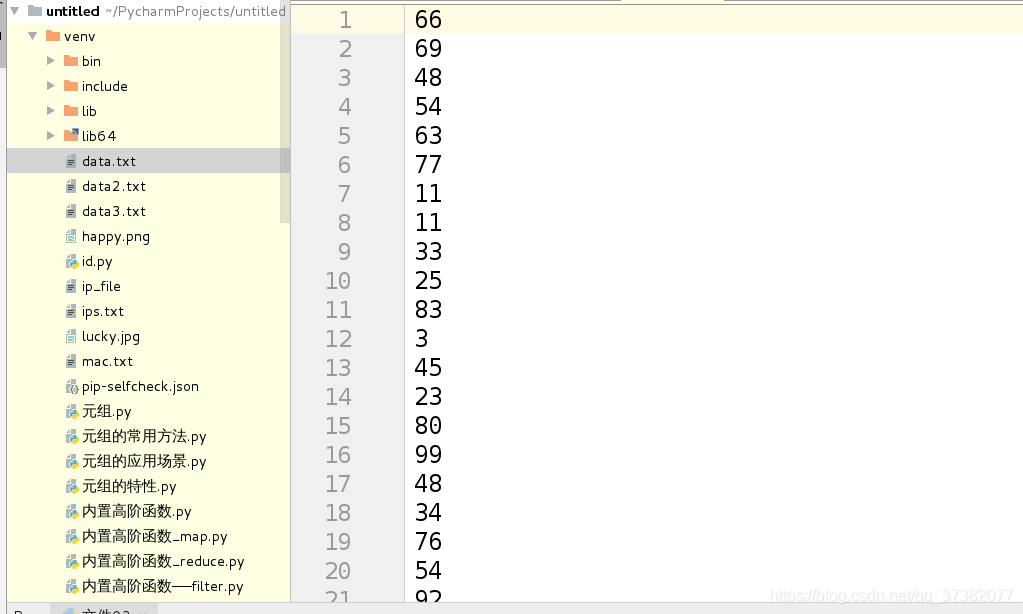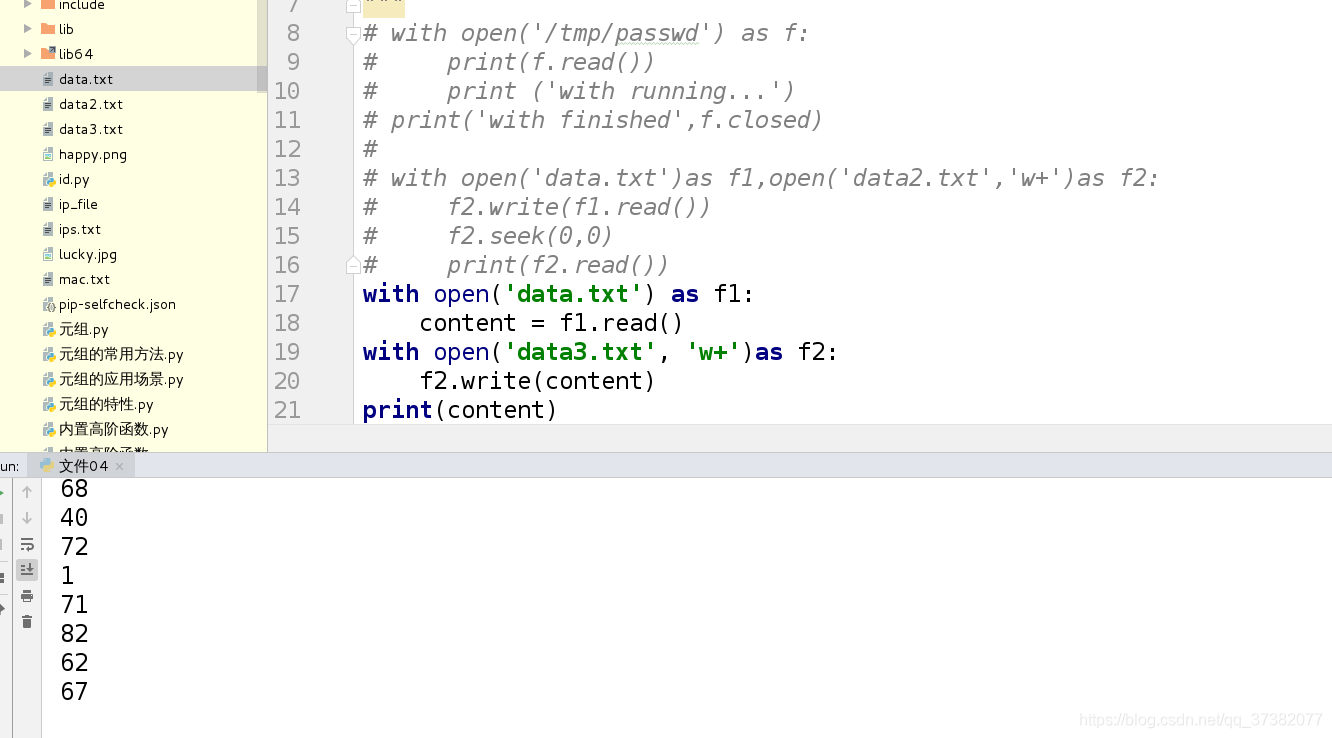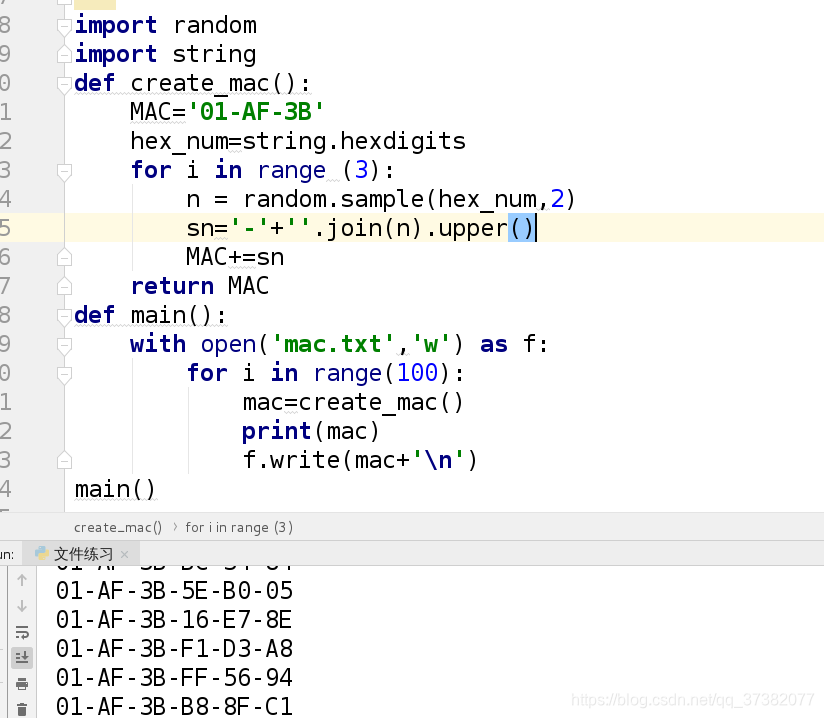"""
1.文件读取的三部曲:打开 ---> 操作 ----> 关闭
r(默认参数):
-只能读,不能写
-读取文件不存在 会报错
FileNotFoundError: [Errno 2] No such file or directory: '/tmp/westos'
w(写)
-write only
-文件不存在的时候,会自动创建新的文件
-文件存在的时候,会清空文件内容并写入新的内容
a(追加):
-write only
-写:不会清空文件的内容,会在文件末尾追加
-写:文件不存在,不会报错,会创建新的文件并写入内容
r+
-r/w
-文件不存在,报错
-默认情况下,从文件指针所在位置开始写入
w+
-r/w
-文件不存在,不报错
-会清空文件内容
a+
-r/w
-文件不存在,不报错
-不会清空文件,在末尾追加
"""
# 1.打开文件
f = open('/tmp/westos','r')
# 2.操作
print(f)
# 读文件
# content = f.read()
# print(content)
# 写文件
# 告诉当前的文件指针所在的位置
# print(f.tell())
# f.write('westos')
# print(f.tell())
# f.write('redhat')
# print(f.tell())
# 判断文件对象拥有的权限
print(f.readable())
print(f.writable())
print(f.tell())
content = f.read()
print(content)
print(f.tell())
content1 = f.read()
print(content1)
# print(content)
# 3.关闭文件
f.close()

“”"
如果读取是 图片 音频 视频(非纯文本文件)
需要通过二进制的方式读取和写入
-读取纯文本
r r+ w w+ a a+ == rt rt+ wt wt+ at at+
-读取二进制文件
rb rb+ wb wb+ ab ab+
“”"
# 先读取二进制文件内容
f1 = open('hello.jpg',mode='rb')
content = f1.read()
f1.close()
f2 = open('lucky.jpg',mode='wb')
# 写入要复制的文件的内容
f2.write(content)
f2.close()

# f = open('/tmp/passwd','rb+')
"""
默认情况下读取文件的内容 小的文件:直接用read读取即可
如果是一个大文件(文件大小>=内存大小) readline()
"""
# 按行读取
# print(f.readline())
# print(f.readline())
# 按字节读取
# print(f.read(3))
# print(f.tell())
# 读取文件内容,并返回一个列表,列表元素分别为文件的行内容
# print(f.readlines())
#指针的移动
# print(f.tell())
# print(f.read(10))
# print(f.tell())
# f.seek(2,2)
"""
seek:指针移动
第一个参数:偏移量 >0:代表向后移动 <0 代表向前移动
第二个参数:
0:移动指针到文件开头
1:当前位置
2:移动指针到末尾
"""
# print(f.tell())
# f.close()
# 读取内容,返回一个列表,去掉后面的\n
f = open('/tmp/passwd')
# print(list(map(lambda x:x.strip(),f.readlines())))
# print([line.strip() for line in f.readlines()])
# f.close()
# 创建文件data.txt 文件共100000行,
# 每行存放以一个1~100之间的整数
import random
f = open('data.txt','a+')
for i in range(100000):
f.write(str(random.randint(1,100)) + '\n')
# 移动文件指针
f.seek(0,0)
print(f.read())
f.close()
 “”"
“”"
上下文管理器:打开文件,执行完with语句内容之后,自动关闭文件
“”"
# f = open('/tmp/passwd')
with open('/tmp/passwd') as f:
print(f.read())
# print('with里面的语句:',f.close())
# print(f.close())
print('after with语句',f.closed)
# 将第一个文件的内容写道第二个文件中
with open('data.txt') as f1,open('data2.txt','w+') as f2:
f2.write(f1.read())
f2.seek(0,0)
print(f2.read())
"""
python2.x
with open(data.txt) as f1:
content = f1.read()
with open(data2.txt,'w+') f2:
f2.write(content)
"""

“”"
生成100个MAC地址并写入文件中,MAC地址前6位(16进制)为01-AF-3B
01-AF-3B-xx-xx-xx
-xx
01-AF-3B-xx
-xx
01-AF-3B-xx-xx
-xx
01-AF-3B-xx-xx-xx
“”"
import string
import random
# hex_num = string.hexdigits
# print(hex_num)
def create_mac():
MAC = '01-AF-3B'
# 生成16进制的数
hex_num = string.hexdigits
for i in range(3):
# 从16进制字符串中随即选出两个数字来
# 返回值是列表
n = random.sample(hex_num, 2)
# 拼接列表中的内容,将小写的字母转换成大写的字母
sn = '-' + ''.join(n).upper()
MAC += sn
return MAC
# 主函数:随即生成100个MAC地址
def main():
# 以写的方式打开一个文件
with open('mac.txt', 'w') as f:
for i in range(100):
mac = create_mac()
print(mac)
# 每生成一个MAC地址,存入文件
f.write(mac + '\n')
main()
 “”"
“”"
京东二面编程题
-
生成一个大文件ips.txt,要求1200行,每行随机为172.25.254.0/24段的ip;
-
读取ips.txt文件统计这个文件中ip出现频率排前10的ip;
“”"import random
def create_ip_file(filename):
ips = [‘172.25.254.’ + str(i) for i in range(0,255)]
print(ips)
with open(filename,‘a+’) as f:
for count in range(1200):
f.write(random.sample(ips,1)[0] + ‘\n’)#create_ip_file(‘ips.txt’)
def sorted_ip(filename,count=10):
ips_dict = dict()
with open(filename) as f:
for ip in f:
if ip in ips_dict:
ips_dict[ip] += 1
else:
ips_dict[ip] = 1
sorted_ip = sorted(ips_dict.items(),
key= lambda x:x[1],reverse=True)[:count]
return sorted_ip
print(sorted_ip(‘ips.txt’,20))






 本文详细介绍了Python中文件的各种操作方法,包括文件的打开、读取、写入及关闭等基本流程。此外,还提供了如何处理不同文件类型(如文本与二进制文件)的具体示例,以及如何使用上下文管理器简化代码。
本文详细介绍了Python中文件的各种操作方法,包括文件的打开、读取、写入及关闭等基本流程。此外,还提供了如何处理不同文件类型(如文本与二进制文件)的具体示例,以及如何使用上下文管理器简化代码。
















 822
822

 被折叠的 条评论
为什么被折叠?
被折叠的 条评论
为什么被折叠?








